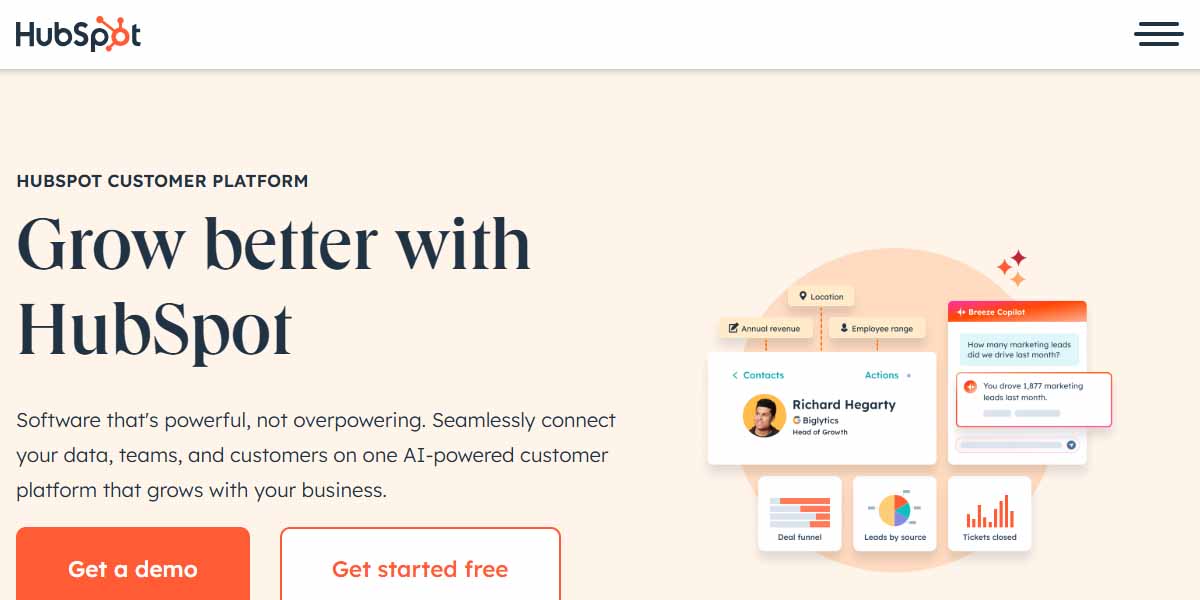We all know how important it is to have the right tools to grow a business, and that’s where HubSpot comes in. It’s an all-in-one platform designed to make your life easier, whether you’re managing leads, building better customer relationships, or running marketing campaigns.
HubSpot takes the complicated stuff and simplifies it so you can focus on what really matters—growing your business.
If you’re new to HubSpot, don’t worry. We’ll walk you through some practical ways you can use it to level up your business strategies. Whether you want to engage more with your customers or make your day-to-day operations run smoother, HubSpot has got you covered. So, let’s dive in and explore how this tool can make a real difference for you.
So……What is HubSpot?
HubSpot is a comprehensive platform for inbound marketing, sales, and customer service. It offers a wide range of tools to help businesses grow. These tools include:
- CRM (Customer Relationship Management)
- Email Marketing
- Social Media Management
- Lead Generation
- Analytics
HubSpot integrates all these tools into one platform. This makes it easier to manage your business. You can track leads, automate emails, and analyze performance. All in one place.
Importance For Entrepreneurs And Marketers
HubSpot is essential for entrepreneurs and marketers. It helps you save time and money. Here are some key benefits:
| Feature | Benefit |
|---|---|
| CRM | Organize customer data easily |
| Email Marketing | Automate campaigns and save time |
| Social Media Management | Schedule posts and track engagement |
| Lead Generation | Capture and nurture leads effectively |
| Analytics | Measure performance and improve strategies |
Using HubSpot, you can focus on what matters most: growing your business. The platform’s tools work together seamlessly. This integration allows you to streamline operations and enhance efficiency.
1. CRM Management
Effective CRM management is essential for entrepreneurs and marketers. HubSpot’s CRM tools can simplify managing customer interactions and sales processes. This section explores how to use HubSpot for CRM management.
Building Customer Relationships
Customer relationships are the heart of any business. With HubSpot, you can manage all interactions in one place. Record every call, email, and meeting. Keep a complete history of each customer. Understand their needs better. Offer personalized service. Build stronger connections.
Tracking Sales Pipelines
Tracking sales pipelines is crucial for business growth. HubSpot offers a visual sales pipeline. Track deals at every stage. Identify potential bottlenecks. Forecast future sales. Keep your team aligned. Make informed decisions. Improve your sales strategy.
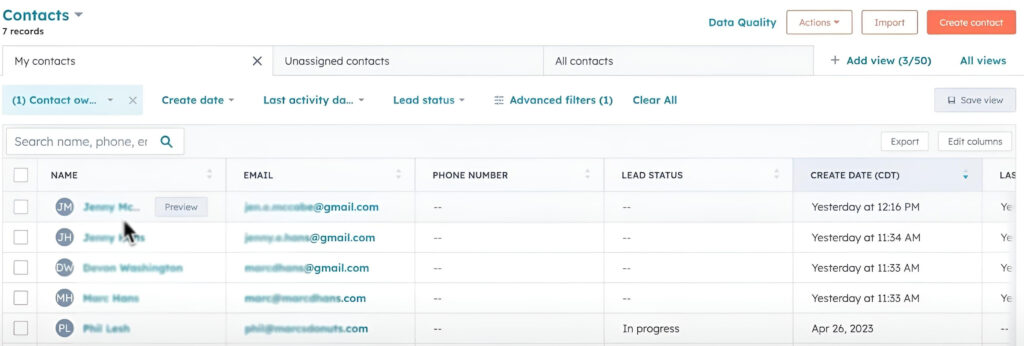
Effortlessly manage your contacts with access to user email addresses, phone numbers, important dates, and more. Enjoy advanced filtering options for easier tracking and streamlined organization.
2. Email Marketing
Email Marketing is an essential tool for entrepreneurs and marketers. It helps build relationships, promote products, and drive engagement. HubSpot provides powerful features to enhance your email marketing efforts.
Designing Effective Campaigns
Creating an effective email campaign involves several key steps. Start with a clear goal. Are you informing, engaging, or selling? Your goal will guide your design.
Use HubSpot’s drag-and-drop editor. It helps design visually appealing emails. Add images, text, and calls-to-action easily. Ensure your emails are mobile-friendly. Many users check emails on their phones.
Personalize your content. Use personalization tokens to address recipients by name. Tailor content based on user behavior and preferences. This increases the relevance and engagement of your emails.
Segment your audience. Not all subscribers are the same. Use HubSpot’s segmentation tools to create targeted lists. Send relevant content to each segment. This boosts open and click rates.
| Step | Action |
|---|---|
| 1 | Define your goal |
| 2 | Use the drag-and-drop editor |
| 3 | Ensure mobile-friendliness |
| 4 | Personalize content |
| 5 | Segment your audience |
Analyzing Email Performance
After sending your email, analyzing its performance is crucial. HubSpot provides detailed analytics. Track metrics like open rates, click rates, and bounce rates.
Open rates indicate how many recipients opened your email. A low open rate means your subject line might need improvement. Test different subject lines to see what works best.
Click rates show the number of recipients who clicked on your links. A low click rate suggests that your content or calls-to-action might not be compelling enough. Adjust your content and test different calls-to-action.
Use HubSpot’s A/B testing feature. Test different variations of your email. Compare their performance to find the most effective version. This helps optimize your future campaigns.
Review your bounce rates. A high bounce rate means your emails aren’t reaching the recipients. Check your email list for invalid addresses. Keep your list clean to improve deliverability.
- Track open rates
- Analyze click rates
- Use A/B testing
- Monitor bounce rates
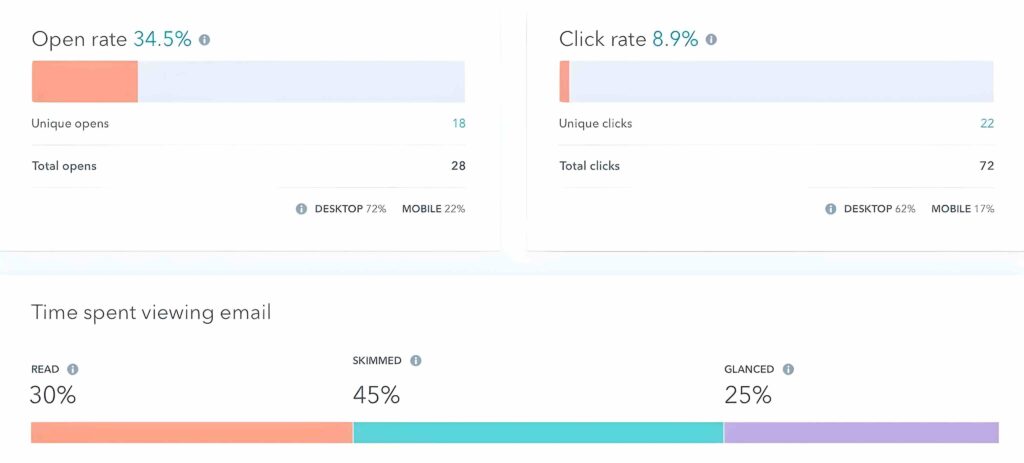
Optimize email campaigns with A/B tests and analytics. Test subject lines to find what drives opens, identify content that boosts engagement and sales, and analyze who’s engaging and when. Use insights to create high-converting email campaigns. HubSpot’s analytics provide valuable insights. Use insights to refine your email marketing strategy. Continuously improve your campaigns for better results.
3. Content Management
Managing content effectively can make or break your marketing strategy. HubSpot offers a suite of tools to help entrepreneurs and marketers create, optimize, and manage content. Let’s explore how you can leverage these tools for maximum impact.
Creating Engaging Content
Creating engaging content is crucial for capturing your audience’s attention. HubSpot’s content management system (CMS) is designed to simplify this process. Here’s how:
- Drag-and-Drop Editor: Easily design web pages without coding skills.
- Content Personalization: Tailor content to different audience segments.
- Blog Management: Schedule and organize blog posts effortlessly.
Brief Overview of Drag and Drop Editor
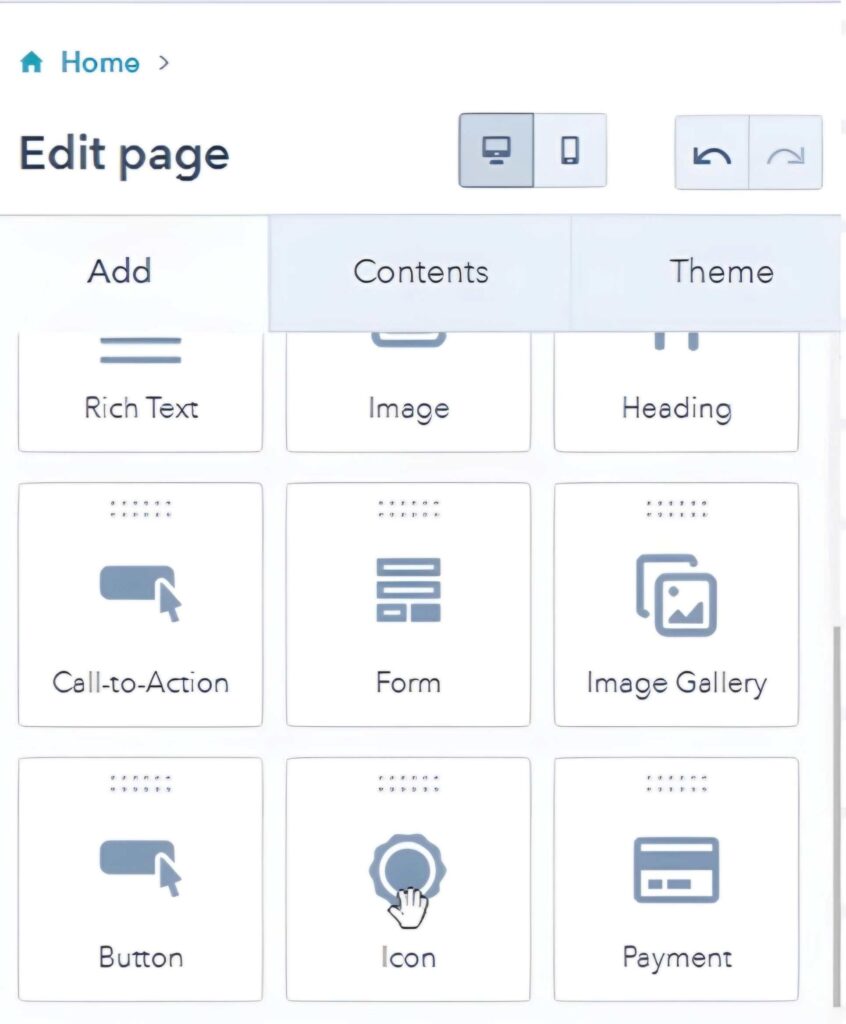
Use the drag-and-drop editor to build visually appealing pages. Personalize content based on user behavior to increase engagement. Schedule blog posts to maintain a consistent content calendar.
Utilizing SEO Tools
Utilizing SEO tools can enhance your content’s visibility on search engines. HubSpot provides integrated SEO tools to help you optimize your content. Here’s what you can do:
- Keyword Suggestions: Discover relevant keywords for your content.
- On-Page SEO Recommendations: Improve your content with actionable tips.
- SEO Analytics: Track and measure your SEO performance.
Use keyword suggestions to find terms your audience searches for. Follow on-page SEO recommendations to optimize your content. Monitor your SEO analytics to understand what’s working and what needs improvement.
HubSpot’s SEO tools help you create content that ranks higher in search results. This increases your website’s visibility and attracts more visitors.
4. Social Media Integration
Social media integration is vital for entrepreneurs and marketers. HubSpot offers robust tools to streamline social media management. From scheduling posts to monitoring engagement, HubSpot simplifies the process.
Scheduling Posts
HubSpot’s scheduling feature saves time. Plan your posts in advance. Choose the best times to reach your audience. This keeps your social media active, even when you are busy.
Use the calendar view to see all your scheduled posts. Adjust dates and times easily. This helps you maintain a consistent posting schedule.
Monitoring Social Engagement
HubSpot’s monitoring tools track social media engagement. See who interacts with your posts. Respond quickly to comments and messages. This builds stronger connections with your audience.
Analyze the data to understand what works best. Adjust your strategy based on insights. This improves your social media efforts over time.
5. Lead Generation
Lead generation is the lifeblood of any entrepreneurial and marketing effort. It involves attracting and converting strangers into someone who has shown interest in your company’s product or service. HubSpot offers a variety of tools to make this process seamless and efficient.
Capturing Leads
HubSpot provides several tools to help you capture leads:
- Forms: Create custom forms to gather essential information from visitors.
- Landing Pages: Design landing pages that encourage visitors to share their contact details.
- Pop-ups: Use pop-up forms to capture leads without interrupting the user experience.
These tools integrate with your CRM, ensuring all leads are captured and organized. This makes follow-up easy and effective. Plus, it saves you time and effort.
Nurturing Prospects
After capturing leads, the next step is to nurture them:
- Email Campaigns: HubSpot allows you to create personalized email campaigns to engage with leads.
- Workflows: Automate your follow-up process with workflows. Send timely emails based on user actions.
- Content Offers: Provide valuable content like eBooks or webinars to keep leads engaged.
HubSpot’s CRM tracks interactions with each lead. This helps you understand their needs and interests better. Therefore, you can tailor your messaging for higher engagement and conversion rates.
By leveraging these tools, entrepreneurs and marketers can efficiently manage and nurture leads. This ensures a steady flow of potential customers.
6. Analytics And Reporting
Analytics and Reporting are crucial for entrepreneurs and marketers using HubSpot. They help you understand your data and make informed decisions. Effective analytics can lead to better strategies and improved results.
Tracking Key Metrics
Tracking key metrics is vital for any business. HubSpot offers tools to track important data. This includes website traffic, lead conversion rates, and sales performance. You can set up custom dashboards to monitor these metrics in real-time. Regularly reviewing these metrics helps you stay on top of your goals.
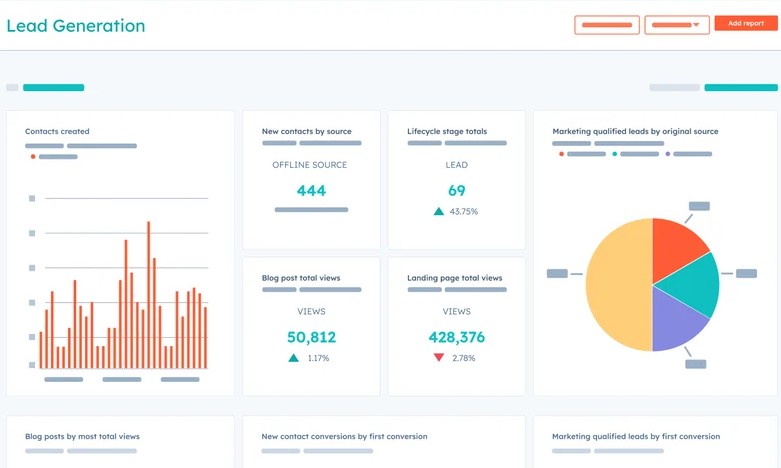
HubSpot’s reporting tools make it easy to visualize data. You can create charts and graphs to see trends. This visual representation helps in understanding complex data quickly. By tracking these metrics, you can identify what works and what needs improvement.
Optimizing Strategies
With HubSpot, you can optimize your marketing strategies. Use the data to see which campaigns perform best. Focus on the channels that bring the most leads. Adjust your efforts based on this data. This ensures you use your resources wisely.
A/B testing is another powerful feature, as discussed earlier. You can test different versions of your content. Analyze the results to see which one performs better. This helps in refining your messaging. You can optimize email campaigns, landing pages, and social media posts.
In summary, using HubSpot’s analytics and reporting tools can enhance your business strategies. By tracking key metrics and optimizing your efforts, you can achieve better results.
7. Customer Support
Effective customer support is vital for any business. HubSpot’s customer support tools help entrepreneurs and marketers manage customer interactions efficiently. This ensures prompt responses and keeps customers satisfied.
Managing Support Tickets
HubSpot allows you to manage support tickets with ease. You can create, track, and organize tickets in one place. This system helps prioritize urgent issues. It also ensures no ticket goes unnoticed. Support agents can see all customer interactions and provide informed responses.
Improving Customer Satisfaction
Happy customers are loyal customers. HubSpot offers various tools to improve customer satisfaction. Automated follow-up emails keep customers informed about their ticket status. Surveys can gauge customer satisfaction and identify areas for improvement. This feedback loop helps refine your support process.
Use HubSpot’s knowledge base to provide customers with self-service options. This reduces the number of tickets and speeds up resolution times. Your customers get answers quickly, and your support team can focus on more complex issues.
8. Automation Workflows
Automation workflows in HubSpot can transform your business processes. These workflows help streamline tasks and enhance productivity. Entrepreneurs and marketers can benefit greatly from these automated sequences. In this section, we will explore how to set up workflows and save time with automation.
Setting Up Workflows
Start by navigating to the workflows tool in HubSpot. Click the “Create workflow” button to begin. Choose a template or start from scratch. Define your enrollment triggers. These triggers determine when contacts enter the workflow. You can set triggers based on form submissions, page views, or list memberships.
Next, add actions to your workflow. Actions can include sending emails, creating tasks, or updating properties. Organize these actions in a logical sequence. Make sure to test your workflow before activating it. This ensures everything functions as expected. Once satisfied, click “Turn on” to activate your workflow.
Saving Time With Automation
Automation workflows save you time by handling repetitive tasks. For example, automate email responses to new leads. This ensures prompt communication without manual effort. Use workflows to nurture leads through the sales funnel. Set up sequences that provide relevant information at each stage.
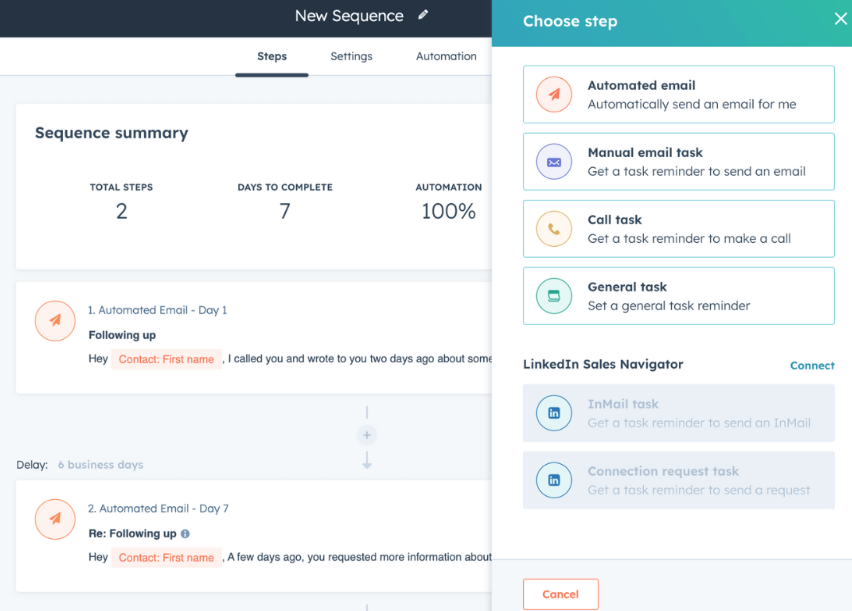
Automate internal tasks as well. Assign tasks to team members automatically. Update contact properties based on their actions. This reduces the need for manual data entry. Overall, automation workflows make your processes more efficient. Your team can focus on strategic activities, improving overall productivity.
9. Integration With Other Tools
HubSpot’s integration with other tools is a powerful feature for entrepreneurs and marketers. Connecting HubSpot with various platforms can streamline workflows and enhance efficiency. Below are some ways to integrate HubSpot with other tools.
Connecting With Sales Platforms
Connecting HubSpot with sales platforms can boost your sales process. HubSpot integrates seamlessly with many popular sales tools. For example, you can link HubSpot with Salesforce to track customer interactions and sales metrics in one place.
Another integration is with Shopify. This connection allows you to manage customer data and sales reports. A table below highlights some key integrations:
| Sales Platform | Key Benefit |
|---|---|
| Salesforce | Unified customer data |
| Shopify | Manage sales and customer info |
10. Enhancing Functionality With Plugins
Plugins can add new features to your HubSpot setup. One popular plugin is the WordPress plugin. It helps in synchronizing your blog posts and lead forms with HubSpot.
Another useful plugin is the Mailchimp plugin. This integration lets you manage email campaigns directly from HubSpot. It simplifies your email marketing efforts. Here are some top plugins:
- WordPress Plugin: Sync blog posts and forms
- Mailchimp Plugin: Manage email campaigns
Integrating these tools can make your marketing campaigns more efficient.
Frequently Asked Questions
What Is Hubspot Used For?
HubSpot is used for inbound marketing, sales, and customer service. It helps manage and automate digital marketing strategies. Entrepreneurs and marketers use it to attract visitors, convert leads, and close customers.
How Can Hubspot Benefit Entrepreneurs?
HubSpot benefits entrepreneurs by providing tools to streamline marketing efforts, improve lead generation, and enhance customer relationships. It offers analytics to track performance and optimize strategies.
Can Hubspot Improve Marketing Campaigns?
Yes, HubSpot can improve marketing campaigns by automating workflows, personalizing content, and providing detailed analytics. It helps marketers target the right audience and measure campaign effectiveness.
Is Hubspot Suitable For Small Businesses?
Yes, HubSpot is suitable for small businesses. It offers scalable solutions that grow with your business. Its user-friendly interface and comprehensive tools make it ideal for small teams.
